Neighboring Towns
CASTEL DEL MONTE
Situated in the mountainous park of Campo Imperatore-Piana di Navelli, Castel del Monte is one of Italy’s “most beautiful villages” according to the National Association of Italian Towns (ANCI). The village provides a vantage of the Tirino Valley with vistas of the provinces of L’Aquila and Pescara. Originally a Roman-era hamlet, Castel del Monte’s documented history dates to the 11th century. Nobile families (Acquaviva, Sforza and Piccolimini) ruled the village prior to a French and a Spanish domination that lasted from 1504 to 1707. Visible today are the crests of Nobile namesakes adorning several buildings in the village. Castel del Monte’s ownership was placed into the hands of the Medici family of Florence after the Spanish period and then it fell to the occupation by Napoleon until 1815. The village exceeded 2,000 inhabitants by the 1920s but as agriculture became less profitable in the region, many families left the village to settle in other parts of the world. Today, tourism brings people back from all over Europe and the Americas. The focal point of Castel del Monte is its “casa torre” (watchtower) built in the Middle Ages.
Location
Castel del Monte is about 8.5 km North of Calascio.
Want to see more?
Visit www.gransassolagapark.it
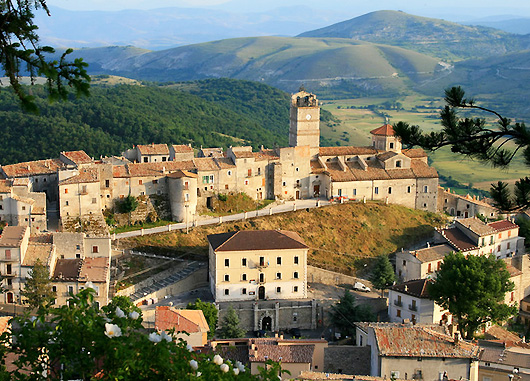
Castel del Monte. Photo credit, www.gransassolagapark.it
OFENA
This village once had a population greater than 2,000 persons prior to WWI and it relied on the economy of the wool trade to survive. Ofena also had economic success processing saffron for export as well as almonds and olive oil but with mass emigration following the two World Wars, the number of Ofena’s inhabitants decreased and the village’s economy grew flat. Today, the village has seen a re-birth in tourism and is now a spot in Abruzzo that lends itself to hiking.
Attractions and Dining
Locanda Collerotondo S.S. 153, 600. 3801862852 (cellular)
Tenuta Cataldi Madonna S.a.s. Since the 1970s this winery has cultivated native varietals of Montepulciano d’Abruzzo, Trebbiano, and Pecorino on 65 acres of vineyards in the valley below Ofena. Their website at www.cataldimadonna.com provides you information about tours and tastings.
Caseificio Aziendale Dal ContaDino. Since the 2000s, this local dairy farm has been producing wonderful and award-winning cheese. It is near Ofena and is open to the public.
Location
Ofena is approximately 10 km East of Calascio.
Want to see more?
Visit www.gransassolagapark.it
Literature about the village
“The Human Life” by Alfredo De Matteis. Published by Theo. Gaus’ Sons, Inc., 1961.
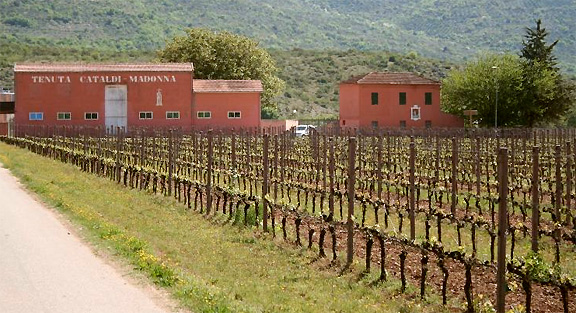
Wine Image Tenuta Cataldi Madonna, Ofena. Photo credit, www.lucianopignataro.it
SANTO STEFANO DI SESSANIO
Since the loss of its iconic Medici watchtower in an April 2009 earthquake, Santo Stefano has made great strides to recover its tourism-based economy. Today, visitors again experience its characteristic medieval appearance. Santo Stefano di Sessanio was developed at the end of the 11th century and then became part of the Barony of Carapelle. By the 18th century it fell under the control of the Kingdom of Naples along with the entirety of the Abruzzi. A visit to the village affords tourists with a choice of independently owned shops and a mix of bars and restaurants open during the summer season. Accommodations are found at Hotel Sextantio: www.santostefano.sextantio.it. To inquire about availability of rooms, email santostefano@sextantio.it
Attractions and Dining
Sotto Gli Archi, Via n. Sauro. +39 0862 899116 or +39 0862 392 002 6267
L’elisir Del Poeta, Piazza Cristoforo Colombo. +39 389 195 5586
Il Ristoro degli Elfi, Via Delle Aie 18. 340 481 9763 (cellular)
Il Cantinone, Via Boragno 7. +39 339 219 9742
Location
Santo Stefano di Sessanio is approximately 7 km Northwest of Calascio.
Want to see more?
Visit www.gransassolagapark.it for more information on the village.
Literature about the village
Through the Apennines and the Lands of the Abruzzi: Landscape and Peasant Life, by Estella Canziani. Published by Houghton Mifflin Company, 1928.
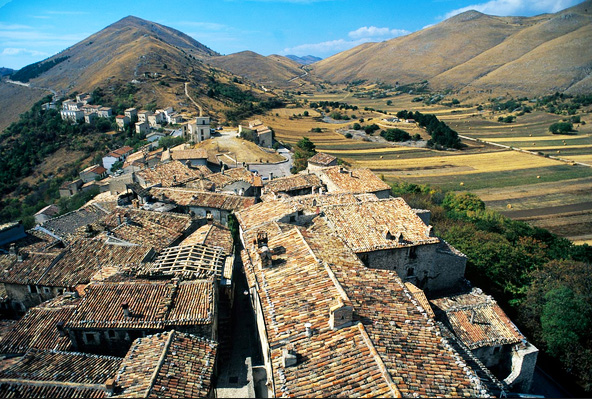
Santo Stefano di Sessanio, overhead. Photo credit, mapio.net
CASTELVECCHIO CALVISIO
This small village is located on the southern side of the Gran Sasso Park. It was developed during the Medieval period and later became a possession of the Barony of Carapelle. It was also at one time under the control of the Acclozamora family of Celano, Abruzzo and later it became a fiefdom under a branch of the Piccolomini family of Siena. Following Piccolomini claims, the village fell under the protection of the Medici family of Florence. An interesting feature of the village is the ancient Chiesa di San Cipriano (Church of Saint Cipriano) dating to the 1400s. This site occupies an area where a Roman Temple once stood in the 8th century.
Attractions and Dining
Trattoria Le Quattro Ville, via Della Mora, 8. 0862 930192, cellular: 339 1288433
Pane e Dolci Calvisio, via parco del gran sasso, 2. 0862 930102
Location
Castelvecchio Calvisio is approximately 6 km South of Calascio.
Want to see more?
Go to www.gransassolagapark.it for more information.
Literature about the village
Through the Apennines and the Lands of the Abruzzi: Landscape and Peasant Life, by Estella Canziani. Published by Houghton Mifflin Company, 1928.
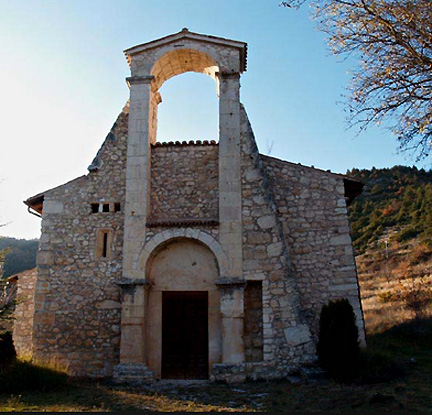
Chiesa di S.Cipriano. Photo credit, www.viaggioinabruzzo.it
CARAPELLE CALVISIO
This is the smallest village on the south central end of the valley of the National Park of the Gran Sasso and it supposedly derives its name from a priestess of the Calvisia family who lived during pre-Christian times. The village passed through Nobile family ownerships during the feudal period and later became a possession of the Barony of Carapelle. In the 1400s, King Ferdinand of Naples donated the barony to the Piccolomini family of Siena and the Piccolomini passed it on to Ottavio Cattaneo of Genoa and then to the Medici of Florence. The village of Capestrano acquired Carapelle and it remained that way until 1860. In 1906, Carapelle became an autonomous village. Due to its location, it was spared damage in the disastrous April 2009 earthquake. Today, Carapelle Calvisio is sparsely populated but a charming location in the National Park of the Gran Sasso.
Location
Carapelle Calvisio is approximately 9.5 km South of Calascio.
Want to see more?
Go to www.gransassolagapark.it for more information.
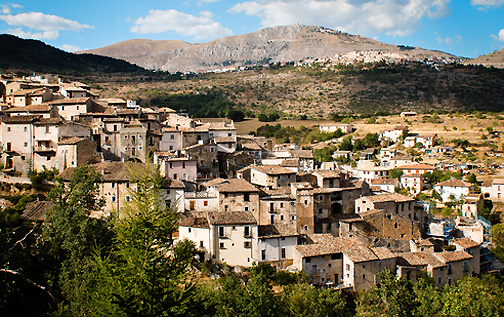
Carapelle Calvisio. Photo credit, comunitaprovvisorie.wordpress.com
BARISCIANO
Situated at the bottom of a wooded hill with a set of medieval ruins, Barisciano was developed in the 8th century from two Roman towns. The village developed as two distinct parts: Upper Barisciano and Lower Barisciano, but the distinction ended in the early 1900s. The village economy was shepherding and agriculture with a majority of the work in cultivation of wheat, saffron, almonds and lentils. After a peak in population, (4,000 residents lived here in the late 1800s), the period following the two World Wars saw a mass exodus of families emigrating to other parts of Europe and to the Americas. Today, Barisciano has a modest revival due to tourism and is worth visiting.
Location
Barisciano is approximately 15 km West of Calascio.
Want to see more?
Go to www.gransassolagapark.it for more information.
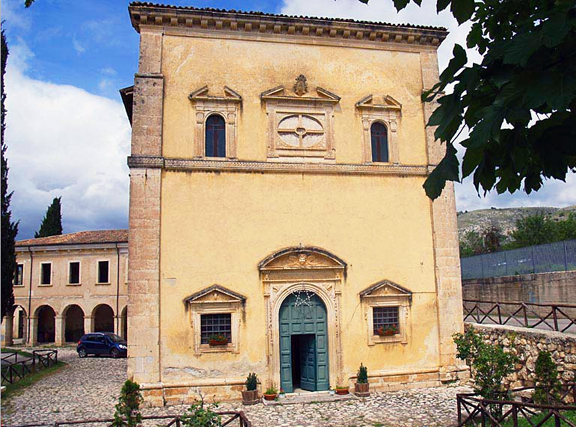
Barisciano. Photo by www.viaggioinabruzzo.it
CAPESTRANO
This village stands out due to the impressive 13th century Castello Piccolomini that serves as the architecrtural focal point of the area. Although the village has origins dating to the Roman-era, its appearance is refined with adornments from the 16th and 17th centuries when Capestrano was a wealthy settlement in Abruzzo. Capestrano is the birthplace of the Franciscan friar, preacher and soldier, Saint John, the saint of military chaplains and jurists. Another noted figure of the village is the archeological icon Nevio Pompuledio, the supposed leader of the Vestini tribe of Abruzzo. The Nevio Pompuledio is also known as the Warrior of Capestrano and it is on display in the Museo archeologico nazionale d’Abruzzo in the town of Chieti.
Location
Capestrano is approximately 18 km southeast of Calascio.
Want to see more?
Go to www.gransassolagapark.it for more information.
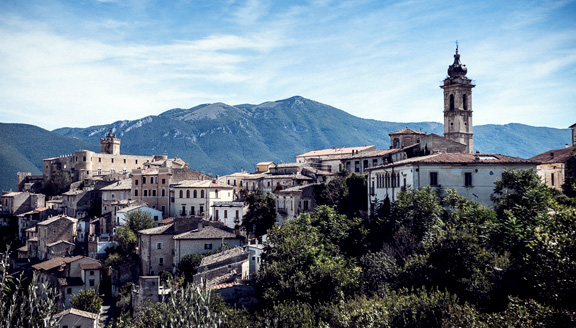
Capestrano. Photo credit, www.salvatorecosta.it
SAN PIO DELLE CAMERE
This small village is south of Calascio down the winding Provincial Road SP8 and is located on the valley floor along State Highway SS17. While it is mostly known for the ruins of its 11th century triangular Castello, many tourists in Calascio find San Pio the most convenient location for a food store, pharmacy, laundry, gas station and building supplies.
Location
San Pio is approximately 24 km south of Calascio.
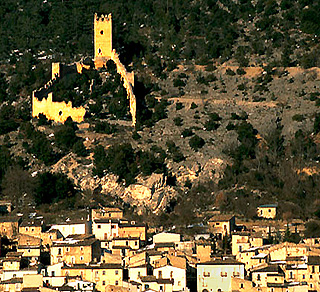
San Pio delle Camere. Photo credit, inAbruzzo.com
Are you contemplating a trip to the Abruzzi? We suggest this website as a starting point, www.abruzzopresto.com and should you have questions about the area around L’Aquila province or about the village of Calascio and the Gran Sasso National Park, contact our website directly: info@calascio.com
